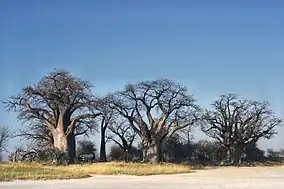| Nxai Pan National Park | |
|---|---|
 Baines Baobabs, Nxai Pan National Park, Botswana | |
| Location | Botswana |
| Coordinates | 20°02′30″S 24°46′08″E / 20.0416666667°S 24.7688888889°E |
| Area | 2578 km² |
| Established | 1992 |
Nxai Pan National Park is a national park in north-eastern Botswana, consisting of Nxai Pan, which is one of the Makgadikgadi Pan salt flats. Nxai Pan National Park lies just north of the Maun-Nata main road and adjoins Makgadikgadi Pans National Park on its northern border. The pan itself is a fossil lakebed about 40 square km in size.[1]
The National Park is also home to the cluster of millennia-old baobab trees, which owe their name to Thomas Baines, the man known to have discovered them. Baines’ Baobabs, as they are known today, are a sight sought by many travelers venturing into this untamed terrain of Botswana.
Wildlife
.jpg.webp)
This national park is home to elephant, giraffe, zebra, wildebeest, lion, leopard, cheetah, kudu, springbok, impala, ostrich, Cape wild dog, jackal, hyena, bat-eared fox, aardwolf, and honey badger.
Conservation
This park is considered for inclusion in the 5 Nation Kavango - Zambezi Transfrontier Conservation Area.
Roads
The rainy season which is from November to April is the hot wet summer season and the time when the park is at its best. Game is abundant from December to April but if the rains have been heavy the roads may be difficult to negotiate. Road conditions can become difficult during times of heavy rains. The more accessible time to be in the park is in the dry season, which is from May to September.[2]
References
- ↑ "Botswana Travel Guide to Nxai Pan". Siyabona Africa. Retrieved 19 September 2014.
- ↑ "Nxai Pan National Park, November 2017". Independent Travellers. independent-travellers.com. Retrieved 30 March 2018.
External links